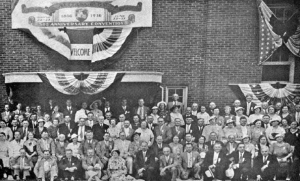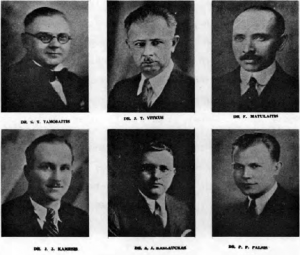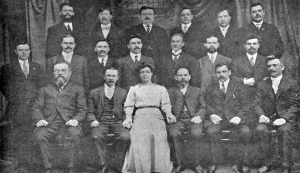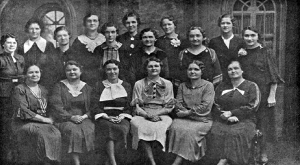Part III: the Lithuanian Community of Cleveland to World War II
Organizations
These newcomers were an added asset to a rapidly growing country, as was attested to by Elizabeth Hughes in 1914. After having completed a study of the Lithuanians in the Fourth Ward in Chicago, Hughes had the following to say, “Thrifty and frugal, intelligent and hardy, they, with their industry and reverence for law, make most desirable immigrants to this country.”[1]
Finding freedoms in the United States not present in their Russian occupied Lithuania, they quickly took advantage of these and followed an instinct to organize.
The first Cleveland organization was the St. George’s Society, founded in 1885.[2] Initially there were thirty-three members, who each paid a one dollar entrance fee and later agreed to pay thirty cents per month. This money went into a fund to be used in case of the sickness or death of a member.[3] In addition to serving local needs, it also worked to help free Lithuania. When Dr. Jonas Basanavičius and Martynas Yčas, both active leaders in Lithuania, came to Cleveland in 1913 to collect money for a National Home in Vilnius, the Society, as well as a number of others donated generously.[4]
Both the Lithuanian Roman Catholic Alliance of America, which established Chapter 8 in Cleveland (in 1902 Chapter 50 was also formed), and the Lithuanian Alliance of America, which founded the 14th Chapter[5] in Cleveland, provided beneficial services, such as unemployment insurance and social security.
Many of the organizations to follow were also benevolent societies. The Lithuanian Warrior Sons of St. Casimir, formed in 1896 for men between the ages of 17 and 36, with a youth section formed later, had impressive uniforms used to represent Lithuania in parades and other national celebrations. Between 1897 and 1916 it had paid out $7,420 to some 295 individuals who had been hospitalized, and between 1910 to 1915 some $1,998.60 to families of deceased members.[6] The society also formed the first Lithuanian library in Cleveland.[7]
In 1906 the first Cleveland Catholic women’s organization was established by Msgr. V. Paukštis. Known as the Society of Blessed Virgin of the Gate of Dawn, it contributed to various funds which were established to free Lithuanians. In the same year Monsignor Paukštis also formed a second group, the Saint Joseph’s Society, a local benevolent society which provided sick and death benefits for its members.[8] Also connected with the church was the St. George’s Choir, formed in 1908 by S. Kimutis to provide services for St. George’s Lithuanian Roman Catholic Church, as well as for other organizations.[9]
In 1909 some members of the Lithuanian Alliance of America formed the Dr. V. Kudirka Society, named after the famous Lithuanian writer Vincas Kudirka. This was also a benevolent society, and to join one had to be a male between the ages of 18 and 45. In that same year another all male organization, the Cleveland Lithuanian National Band, was formed by Reverend J. Halaburda, pastor of St. George’s Church who was instrumental in collecting money from various organizations to provide uniforms and instruments for the band.[10] In addition to playing for various Lithuanian functions, the band also would go from house to house in a Lithuanian neighborhood and play Lithuanian carols during the Christmas season.[11]


The Lithuanian organizations founded up to 1917 are numerous. Included are Chapters 20 and 47 of the Lithuanian Patriots Association, the Cleveland Lithuanian Building and Loan Association, which will be dealt with in detail later, and the Cleveland Lithuanian Theatrical Choral Society, which was formed in 1909. This group performed dramas, and gave concerts, operettas and recitations that often dealt with Lithuanian patriotic themes.
In 1911 the Cleveland Lithuanian Society Hall Company was formed, which will also be discussed later; and in 1913 Chapter 142 of the Lithuanian Roman Catholic Alliance of America was established. The following year another very important cultural organization, Chapter 25 of the Knights of Lithuania, came into being. This youth organization performed a similar service to the community as did the Cleveland Lithuanian Theatrical Society.[12] One member of the Cleveland Knights of Lithuania, Juozas Sadauskas, performed in over one-hundred plays and told of how the group used to travel to Pittsburgh, Detroit, and other communities to entertain Lithuanian communities.[13]
In 1916 a second band was formed, the Lithuanian Son’s Band. This group, founded by Jonas Čepurna and Juozas Marozas, had as its goal the teaching of Lithuanian youth a love for the art and music of Lithuania.[14] This patriotic enthusiasm was likely the result of the First World War, then in progress, and the idea of Lithuania becoming independent, aided by President Woodrow Wilson’s famous Fourteen Points, which among other things called for national self-determination. This hope for independence was also witnessed by the formation in Cleveland of Section 22 of the National Fund and Chapter 18 of the American Lithuanian National League in 1916. The main purpose of the Fund was to collect money to aid Lithuania, and the Cleveland section did admirably. On March 5, 1916, at St. George’s Church, a “Lithuanian Day” was held and $400 collected. This, along with donations from other Lithuanian organizations and individuals, produced over $2000 in Cleveland in less than a year.
The goal of the Lithuanian American National League, in addition to looking after the political and cultural needs of Lithuanians in America and Lithuania, was to fight for the future of a free Lithuania.[15]
The formation of the National Guards of Vytautas the Grand Duke of Lithuania was another sign of the times. Dressed very neatly in stylish uniforms and mounted on horseback, this group participated in many liberty bond parades, thus providing the non-Lithuanians in Cleveland a chance to become acquainted with the existence of the small nation on the shores of the Baltic sea.[16]


Also formed in 1916 was Chapter 26 of the Lithuanian Roman Catholic Womens’ Alliance.[17] Perhaps the best description of this group was given by Charles W. Coulter in his study of Lithuanians in Cleveland in 1920: “Although its purpose is primarily life insurance, it is one of the most progressive and versatile racial [sic] clubs in this city. It stages dramatics, gives suppers and dances, does Red Cross work, and has interested itself in women’s suffrage. Instruction is provided in cooking, homemaking and physical culture. It is the only Lithuanian member of the Cleveland Federation of Women’s Clubs.”[18]
The society of the Cleveland Lithuanian Varpas Choir, founded in 1917, also added to cultural life. It was a 25 member all male group that specialized in the Lithuanian folksong or Daina[19] and performed before many Cleveland audiences.
In 1914, in order to have some form of unity and coordination between all of the Catholic and nationalist organizations, the Cleveland Lithuanian Unity Society was organized.[20] In studies completed on Lithuanians, their tendency to unite and form these various organizations was recognized. Concerning this trait the following comment was made in a work, edited by Francis J. Brown and Joseph Slabey Roucek: “The tendency of the Lithuanians to form settlements enables them to organized their social life through social, literary, religious, beneficial, and cooperative societies, imitating as far as possible their institutions at home. A conservative estimate places the number of charitable and mutual-aid organizations at over two thousand.”[21] Coulter made the following statement, “Few people have a greater native genius for social organization than the Lithuanians. For years this instinct has been repressed by Russia. In America it breaks out in a riotous and surprising spontaneity. There is an organization for almost every purpose, and always a remarkable manifestation of facility for team work between societies as well as between individuals.”[22]
Another type of organization, however, took place within the liberal political segment of Lithuanian society. Often grouped together, they were simply called communists by the owners of industry, who feared unionization and the threat of Marxism, particularly after the Russian Revolution in 1917. The majority of the Lithuanian liberals, however, were only fighting for improved working conditions and by today’s standards would be considered far from radical by most. Nevertheless, at that time they tended to operate separately from the nationlists and Catholics in the Lithuanian community.
Two of these liberal groups deserve special mention for their roles in the history of Lithuanians in Cleveland. The first was the Lithuanian Socialist Party. In 1904 a central committee was selected to convene a congress of the various Lithuanian socialist groups in the United States the following year. The organizer of this central committee was Karolis Rutkus of Cleveland, and when the group met the following year in Newark, New Jersey, six representatives from Cleveland attended. Included in the platform was a pledge to work to organize American Lithuanians on socialist grounds, to work with the American Socialist Party, and to fight the clergy who stood in their way.[23] This last point, of course, greatly reduced the chances of any meaningful dialogue with the Catholic segment of Lithuanian society.
The second of the liberal groups was the Lithuanian Workers’ Association. This group, formed during the depression years, held its first congress in Cleveland in June, 1932. While holding socialist views, it was also a beneficial society, and was very active with youth. The chapters had their own basketball and softball teams, which participated in national competition with other Association teams, and also held an olympic tournament in Cleveland in 1938.[24] In the cultural area the group was busy in the production of plays and musical shows.
- Elizabeth Hughes, "Chicago Housing Conditions, IX: The Lithuanians in the Fourth Ward", The American Journal of Sociology, XX (November 1914), 291. ↵
- Jonas, Lietuviai, 138. ↵
- Sakalauskas, Clevelando, 6. ↵
- Sakalauskas, Clevelando, 15. ↵
- Sakalauskas, Clevelando, 15, 16. ↵
- Sakalauskas, Clevelando, 20-29. ↵
- L.E., IV, 61. ↵
- Sakalauskas, Clevelando, 30-35, 44. ↵
- Sakalauskas, Clevelando, 47. ↵
- Sakalauskas, Clevelando, 49-56. ↵
- Interview with Frank O'bell on 4 April 1975. ↵
- Sakalauskas, Clevelando, 58-88. ↵
- Interview with Juozas Dakauskas on 14 April 1972. ↵
- Sakalauskas, Clevelando, 88, 89. ↵
- Sakalauskas, Clevelando, 89-92. ↵
- Sakalauskas, Clevelando, 93-98. ↵
- Sakalauskas, Clevelando, 99. ↵
- Coulter, The Lithuanians, 18. ↵
- Sakalauskas, Clevelando, 101. ↵
- Sakalauskas, Clevelando, 103. ↵
- Francis J. Brown and Joseph Slabey Roucek (eds.), Our Racial and National Minorities (New York, 1937), 276. ↵
- Coulter, The Lithuanians, 12, 13. ↵
- Michelsonas, Lietuvių, 78, 79. Širvydas, Juozas D., 218, 219. ↵
- Jonas Ormanas, Jonas Gasiūnas, and Rojus Mizara (eds.), L.D.S. Paveikslouse (A Portrait of the Lithuanian Workers' Association), (Brooklyn, 1940), 16, 17, 33. Romejus ir Julyte, (Cleveland, 1924). ↵
